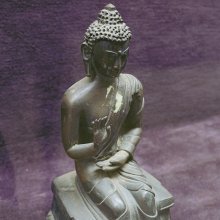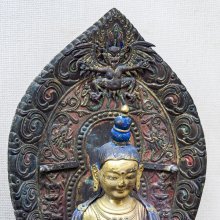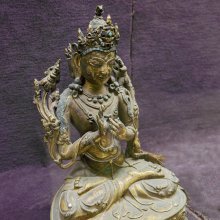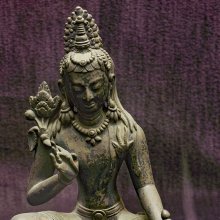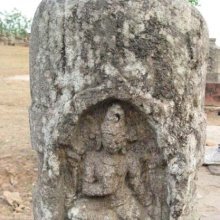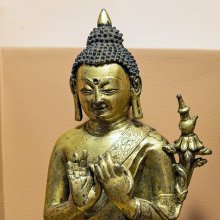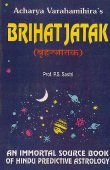Maitreya, Maitrēya: 33 definitions
Introduction:
Maitreya means something in Buddhism, Pali, Hinduism, Sanskrit, the history of ancient India, Marathi. If you want to know the exact meaning, history, etymology or English translation of this term then check out the descriptions on this page. Add your comment or reference to a book if you want to contribute to this summary article.
Images (photo gallery)
(+44 more images available)
In Hinduism
Purana and Itihasa (epic history)
Source: archive.org: Puranic EncyclopediaMaitreya (मैत्रेय).—A sage of great brilliance of ancient India. Genealogy. Descending in order from Viṣṇu:—Brahmā—Atri—Candra—Budha—Purūravas—Āyus—Anenas—Pratikṣatra—Sṛñjaya—Jaya—Vijaya—Kṛti—Haryaśva—Sahadeva—Nadīna—Jayasena—Saṅkṛti—Kṣatradharmā—Sumagotra—Śala—Ārṣṭiṣena—Kośa—Dīrghatapas—Dhanvantari—Ketumān—Bhīmaratha—Divodāsa—Maitreya.
Somapa was born as the son of Maitreya. Other details.
(i) Once Maitreya went to Hastināpura and told Duryodhana that he should behave kindly to the Pāṇḍavas. Duryodhana who did not much relish the advice sat tapping on his thighs with his hands, not seriously attending to the sage. Maitreya was displeased at the discourtesy and cursed that Bhīma would one day break Duryodhana’s thighs. (See under Duryodhana).
(ii) Maitreya was a courtier of Yudhiṣṭhira. (Śloka 10, Chapter 4, Sabhā Parva).
(iii) Maitreya was one among the sages who visited Bhīṣma while he was lying on his bed of arrows. (Śloka 6, Chapter 43, Śānti Parva).
(iv) Once he discussed with Vyāsa topics on Dharma. (Chapter 120, Anuśāsana Parva).
(v) When Srī Kṛṣṇa died, the spiritualistic ideology of Dharmaputra became more dominant and he approached Vidura for Dharmopadeśa. Vidura sent him to Maitreya. Dharmaputra went to the Āśrama of Maitreya on the banks of the river Gaṅgā and after paying respects to him accepted Dharmopadeśa (Instruction in law, duty and morals) from him. (3rd Skandha, Bhāgavata). (See full article at Story of Maitreya from the Puranic encyclopaedia by Vettam Mani)
Source: Cologne Digital Sanskrit Dictionaries: The Purana Index1a) Maitreya (मैत्रेय).—(also Kauṣārava); a son of Mitrā; a siddha; himself a Purāṇa of information;1 went with Kṛṣṇa to Mithilā; met Kṛṣṇa on the eve of his departure to Heaven, and was ordered to be the preceptor to Vidura; the latter met him on the Ganges and after describing the creation of the world, answered Vidura's questions.2 Taught him ātma vidyā and told him that the goal was Hari;3 was invited for the Rājasūya of Yudhiṣṭhira.4
- 1) Bhāgavata-purāṇa III. 4. 36; VI. 15. [14]; III. 7. 42.
- 2) Ib. X. 86. 18; III. 4. 9 and 26; 5. 1 and 22-36; 8. 1ff.
- 3) Ib. I. 13. 1; 19. 10; II. 10. 49.
- 4) Ib. X. 74. 7; XII. 12. 8.
1b) A name of Maitrāyaṇavara.*
- * Matsya-purāṇa 50. 13.
1c) A pupil of Parāśara; enquired of him as to the origin of the world.*
- * Viṣṇu-purāṇa I. 1. 10.
1d) Ārṣeyapravaras; (Bhārgavas).*
- * Matsya-purāṇa 195. 40.

The Purana (पुराण, purāṇas) refers to Sanskrit literature preserving ancient India’s vast cultural history, including historical legends, religious ceremonies, various arts and sciences. The eighteen mahapuranas total over 400,000 shlokas (metrical couplets) and date to at least several centuries BCE.
Ayurveda (science of life)
Dietetics and Culinary Art (such as household cooking)
Source: Shodhganga: Dietetics and culinary art in ancient and medieval IndiaMaitreya (मैत्रेय) is the name of an author of books dealing with the topics of dietetics and culinary art, also known as Pākaśāstra or Pākakalā as quoted by Raghunātha in his 17th century Bhojanakutūhala.—It is a noticeable fact that Āyurveda and its tradition, stood as the champions for the development of critical notions of dietetics and culinary art in ancient and medieval India. [...] Bhojanakutūhala records many earlier important treatises [...] and quotes many other scholars like [...] Maitreya.

Āyurveda (आयुर्वेद, ayurveda) is a branch of Indian science dealing with medicine, herbalism, taxology, anatomy, surgery, alchemy and related topics. Traditional practice of Āyurveda in ancient India dates back to at least the first millenium BC. Literature is commonly written in Sanskrit using various poetic metres.
Vaishnavism (Vaishava dharma)
Source: Pure Bhakti: Brhad BhagavatamrtamMaitreya (मैत्रेय) refers to:—A disciple of Mahaṛṣi Parāśara, the father of Vyāsadeva, and a great sage and learned philosopher; one of the speakers of Śrīmad Bhāgavatam. (cf. Glossary page from Śrī Bṛhad-bhāgavatāmṛta).

Vaishnava (वैष्णव, vaiṣṇava) or vaishnavism (vaiṣṇavism) represents a tradition of Hinduism worshipping Vishnu as the supreme Lord. Similar to the Shaktism and Shaivism traditions, Vaishnavism also developed as an individual movement, famous for its exposition of the dashavatara (‘ten avatars of Vishnu’).
General definition (in Hinduism)
Source: Apam Napat: Indian MythologyMaitreya was a sage. His lineage is unknown. He came to the court of Hastinapura to advice Duryodhana to restore the kingdom of the Pandavas, a little while after the sons of Pandu had gone into exile, having been defeated at dice. (See "Events in Hastinapura")
However, Duryodhana didn't even bother to listen to the sage, and showed his disrespect all too plainly. Incensed, the sage cursed him and said,
"Fourteen years hence, you shall be destroyed in battle by the Pandavas, along with your kinsmen and all that you hold dear. Bheema shall despatch you to the abode of Yama, by breaking your thighs with the mace."
Some hold that the curse of this sage played a major part in encompassing the destruction of the Kauravas.
Source: WikiPedia: HinduismMaitreya (मैत्रेय): A sage who visited the court of Dhritarashtra, expressed sorrow at the Pandava's plight, advised Duryodhana not to injure the Pandavas for his own good.
In Buddhism
Tibetan Buddhism (Vajrayana or tantric Buddhism)
Source: Wisdom Library: MañjuśrīnāmasaṃgītiMaitreya (मैत्रेय) is one of the sixteen bodhisattvas appearing in the Vajradhātu-mahāmaṇḍala, according to the Nāmamantrārthāvalokinī v5.38-41. The Nāmamantrārthāvalokinī (literally, ‘an explanation of the nāma-mantras’) is a commentary (ṭīkā) on the 8th century Mañjuśrīnāmasaṃgīti.
Maitreya is a name of Mañjuśrī (the embodiement of non-dual knowledge) and, together with other names, forms the core essence of the Mañjuśrīnāmasaṃgīti. The Nāmamantrārthāvalokinī provides the practitioner a sādhana (‘meditative practice’) to turn these names into mantras. These mantras are chanted for the benefit of all beings, and then placed and contemplated in the Vajradhātu-mahāmaṇḍala, which is an extended version of the Vajradhātu-maṇḍala.
Source: Wisdom Library: Tibetan BuddhismMaitreya (मैत्रेय) is the name of a Bodhisattva mentioned as attending the teachings in the 6th century Mañjuśrīmūlakalpa: one of the largest Kriyā Tantras devoted to Mañjuśrī (the Bodhisattva of wisdom) representing an encyclopedia of knowledge primarily concerned with ritualistic elements in Buddhism. The teachings in this text originate from Mañjuśrī and were taught to and by Buddha Śākyamuni in the presence of a large audience (including Maitreya).
Source: Google Books: Mahāmudrā and Related InstructionsMaitreya (मैत्रेय) (or Ajita) is the name of an ancient teacher belonging to the “lineage of vast conduct”, according to “the succession of Gurus in the Mahāmudrā lineages” in the Kagyü School of Tibetan Buddhism (the Mahāmudrā deals with the nature of the mind).—The graduated path of the three levels of beings, which is an adornment [for the Mahāmudrā], is of three lineages: 1. The lineage of vast conduct; 2. The lineage of the profound view; 3. The lineage of the blessing of practice.—[The lineage of vast conduct]—(1) The Lord of Sages [the Buddha], ... (2) Regent Ajita [Maitreya],... and (14) Atiśa Dīpaṃkara.
Source: archive.org: The Indian Buddhist IconographyMaitreya (मैत्रेय) refers to the Future Buddha (he partakes of the nature of a Mortal Buddha, though he is not a Buddha yet), and is a Bodhisattva commonly depicted in Buddhist Iconography, such as the 11th-century Niṣpannayogāvalī of Mahāpaṇḍita Abhayākara.—his color is golden-yellow; his symbol is the nāgakeśara flower.—Maitreya is supposed to be passing the life of a Bodhisattva in the Tuṣita heaven, preparatory to his descent to earth in human form. It is said that he will come to earth full 4000 years after the disappearance of Buddha Gautama for the deliverance of all sentient beings. The Nāgakeśara flower is his chief recognition symbol both in China and in India. He is found also in Tibet.
Maitreya is described in the Niṣpannayogāvalī as follows:—
(1: Mañjuvajra-maṇḍala):—“Maitreya is of golden colour. With the two principal handshe displays the Dharmacakra-mudrā. The other two hands show the Varada-mudrā in the right and the twig of a Nāgakeśara with flower in the left”. (2: Durgatipariśodhana-maṇḍala):—“Maitreya is yellow in colour. He holds in his right hand the flower of Nāgakeśara and with the left the mendicant bowl”. (3: Sādhanamālā):—“Maitreya is yellow in colour and shows the Nāga flower and the Varada-mudrā”.
Maitreya is described in the Sādhanamālā and the Sādhana describing the procedure of his worship has Dhyāna: “The worshipper should meditate himself as Maitreya who originates from the yellow germ syllable ‘Maiṃ’. He is three-faced, three-eyed, and four-armed. His right and left faces respectively are of blue and white colour. His complexion is yellow like that of gold. He sits in the Paryaṅka attitude on an animal His two hands are engaged in exhibiting the Vyākhyāna Mudrā and he shows in his other right and left hands the Varada Mudrā and afull-blown Nāgakeśara flower with its branches He is decked in many ornaments. Meditating thus... This is the Sādhana for Maitreya”.
Source: Brill: Śaivism and the Tantric Traditions (tantric Buddhism)Maitreya (मैत्रेय) refers to one of the sixteen Bhadrakalpa Bodhisattvas, according to the Niṣpannayogāvalī 44ff and Abhayākaragupta’s Durgatipariśodhana-maṇḍala (Cf. Niṣpannayogāvalī 66ff.).—A set of sixteen Bodhisattvas often supplements the deities of the Tattvasaṃgraha in later Vajradhātu-maṇḍala descriptions. These are generally the sixteen Bodhisattvas of the present aeon (bhadrakalpa) [e.g., Maitreya], as described for example in Abhayākaragupta’s Niṣpannayogāvalī Vajradhātu-maṇḍala.—Cf. also Nāmamantrārthāvalokinī and Abhayākaragupta’s forty-three deity Mañjuvajra-maṇḍala (Tricatvāriṃśadātmakamañjuvajra-maṇḍala: see Niṣpannayogāvalī 50)

Tibetan Buddhism includes schools such as Nyingma, Kadampa, Kagyu and Gelug. Their primary canon of literature is divided in two broad categories: The Kangyur, which consists of Buddha’s words, and the Tengyur, which includes commentaries from various sources. Esotericism and tantra techniques (vajrayāna) are collected indepently.
Mahayana (major branch of Buddhism)
Source: Wisdom Library: Mahayana BuddhismMaitreya (मैत्रेय) is the name of a Bodhisattva, included in the list of spiritual friends of Sudhana: the son of a merchant from Sukhākara who received a prophecy from Mañjuśrī, according to the Avataṃsaka-sūtra. Accordingly, Sudhana devoted himself to 110 spiritual friends in a great building adorned with the ornaments of Vairocana. These spiritual friends included monks, bodhisattvas (e.g., Maitreya), ṛṣis, brāhmaṇas, girls, kings, youths, goddesses, householders, etc. From these beings, Sudhana took the vows without the need for any formal basis.
Source: Wisdom Library: Maha Prajnaparamita SastraMaitreya (मैत्रेय) is one of the Bodhisattvas accompanying the Buddha at Rājagṛha on the Gṛdhrakūṭaparvata, mentioned in a list of twenty-two in to Mahāprajñāpāramitāśāstra chapter 13.—They were at the head of countless thousands of koṭinayuta of Bodhisattva-mahāsattvas who were all still awaiting succession and will still accede to Buddhahood. He is also known as Mi lö or Ts’eu che.
Maitreya is one of the six classified as a monastic (pravrajita) Bodhisattva.
Source: academia.edu: A Study and Translation of the GaganagañjaparipṛcchāMaitreya (मैत्रेय) is the name of a Bodhisattva, according to the Gaganagañjaparipṛcchā: the eighth chapter of the Mahāsaṃnipāta (a collection of Mahāyāna Buddhist Sūtras).—Accordingly, “Then the Bodhisattva Gaganagañja said this to the congregation of Bodhisattvas: ‘Sons of good family, may all of you elucidate the gates into the dharma of transcending the path of the works of Māra’ [...] The Bodhisattva Maitreya said: ‘Just as the water in the great ocean has a single taste, so all dharmas in the great ocean of the knowledge of the dharma have a single taste. Since the works of the Māra and the works of the Buddha, both are same in the perspective of emptiness, signlessness, wishlessness, birthlessness, and the absence of origination, the Bodhisattva who enters into the single taste transcends the sphere of the Māra’”.

Mahayana (महायान, mahāyāna) is a major branch of Buddhism focusing on the path of a Bodhisattva (spiritual aspirants/ enlightened beings). Extant literature is vast and primarely composed in the Sanskrit language. There are many sūtras of which some of the earliest are the various Prajñāpāramitā sūtras.
General definition (in Buddhism)
Source: Wisdom Library: Buddhism1) Maitreya is the future Buddha, who will be born 30,000 years from now. The Chinese monk called Pu-tai (Ho-tei in Japanese) -- “the laughing buddha” -- is considered a pre-incarnation of Maitreya.
2) Maitreya:—(Also called ‘Ajita’) He is the Bodhisattva that will take Shakyamuni’s place in this world as the next Buddha some five and a half million years from now.
Source: Wisdom Library: Dharma-samgrahaMaitreya (मैत्रेय) refers to the first of the “eight Bodhisattvas” (aṣṭabodhisattva) as defined in the Dharma-saṃgraha (section 12). The Dharma-samgraha (Dharmasangraha) is an extensive glossary of Buddhist technical terms in Sanskrit (e.g., aṣṭa-bodhisattva and Maitreya). The work is attributed to Nagarguna who lived around the 2nd century A.D.
Source: Buddhist Door: GlossarySanskrit word, literally means friendly and benevolent. He will be the next Buddha in our world. He is now preaching in Tusita Heaven. He is usually represented as the fat laughing Buddha.Source: The Art of Asia: Who is Who in HeavenMaitreya (Chinese: Mi lo; Japanese: Miroku), the Buddha of the Future, believed to reside in the Tsushita Heaven until it is time for him to succeed Shakyamuni as the next incarnation of Buddhahood on earth.
Source: WikiPedia: BuddhismMaitreya or Metteyya (Pali) is a future Buddha of this world in Buddhist eschatology. In some Buddhist literature, such as the Amitabha Sutra and the Lotus Sutra, he is referred to as Ajita Bodhisattva.
Maitreya is a bodhisattva who in the Buddhist tradition is to appear on Earth, achieve complete enlightenment, and teach the pure dharma. According to scriptures, Maitreya will be a successor of the historic Sakyamuni Buddha, the founder of Buddhism. The prophecy of the arrival of Maitreya is found in the canonical literature of all Buddhist sects (Theravada, Mahayana, Vajrayana) and is accepted by most Buddhists as a statement about an actual event that will take place in the distant future.
Source: Shambala Publications: GeneralMaitreya Skt. (Jap., Miroku), lit., “Loving One”; in the teaching of the five earthly buddhas, already present in the Hīnayāna but first fully developed by the Mahāyāna, the embodiment of all-encompassing love. He is expected to come in the future as the fifth and last of the earthly buddhas. The cult of Maitreya is very widespread in Tibetan Buddhism. His Heaven is tushita (“the joyful”), after which the Tibetan saint Tsongkhapa named the first monastery he founded. As the world teacher to come, Maitreya is expected to appear in around thirty thousand years.
India history and geography
Source: What is India: Inscriptions of the Early Gupta KingsMaitreya (मैत्रेय) or Mitra refers to one of the four disciples of Lakulī (the last incarnation of Maheśvara).—Lakulī had four ascetic pupils, namely, Kuśika, Garga, Mitra and Kauruṣya. The same information is contained in a stone slab inscription, which originally belonged to a temple at Somanātha [= Somnath] in Kathiawad [Kathiyawadi?]. [...] The order and names of his pupils are, however, slightly different in this epigraphic record, being Kuśika, Gārgya, Kauruṣa and Maitreya. [...] The Cintra praśasti, however, tells us one thing more, namely, that these four disciples of Lakulī were the founders of four lines amongst the Pāśupatas.

The history of India traces the identification of countries, villages, towns and other regions of India, as well as mythology, zoology, royal dynasties, rulers, tribes, local festivities and traditions and regional languages. Ancient India enjoyed religious freedom and encourages the path of Dharma, a concept common to Buddhism, Hinduism, and Jainism.
Languages of India and abroad
Marathi-English dictionary
Source: DDSA: The Molesworth Marathi and English Dictionarymaitrēya (मैत्रेय).—a S Relating to friend, friendly.
Source: DDSA: The Aryabhusan school dictionary, Marathi-Englishmaitrēya (मैत्रेय).—a Relating to a friend, friendly.
Marathi is an Indo-European language having over 70 million native speakers people in (predominantly) Maharashtra India. Marathi, like many other Indo-Aryan languages, evolved from early forms of Prakrit, which itself is a subset of Sanskrit, one of the most ancient languages of the world.
Sanskrit dictionary
Source: DDSA: The practical Sanskrit-English dictionaryMaitreya (मैत्रेय).—a. (-yī f.) Relating to a friend, friendly.
-yaḥ Name of a mixed tribe.
Source: Cologne Digital Sanskrit Dictionaries: Edgerton Buddhist Hybrid Sanskrit DictionaryMaitreya (मैत्रेय) or Maitraka.—(1) (only in verses and probably m.c.): °ku (n. sg.) Gaṇḍavyūha 488.25; °kasya 489.7.
--- OR ---
Maitreya (मैत्रेय) or Maitranātha.—(1) (in verse, probably m.c.): °tha (n. sg.) Gaṇḍavyūha 489.8.
--- OR ---
Maitreya (मैत्रेय).—(1) also Maitriya m.c., and Maitraka, Maitra-nātha, °nāman, and perhaps Maitrīya, qq.v.; = Pali Metteyya), name of the next Buddha to follow Śākya- muni, predicted by him; has special epithet Ajita, q.v.: Saddharmapuṇḍarīka 3.9; 7.4 ff.; 302.11, 16; 307.11; 308.1; 309.1; 310.13; 311.1; 312.13; 315.5; 316.12; 327.2; 329.11; 332.5; 345.1 ff.; 478.11; Mahāvastu i.59.2 (etc., see Senart's Index); iii.240.11 ff.; 243.19; 246.16; 247.15; 330.8; Lalitavistara 2.10 (first of a list of Bodhisattvas); 39.2 ff.; 422.7, 11; 443.7; 444.12; Mahāvyutpatti 646 (= Tibetan byams pa, second in a list, after Avalokiteśvara); Divyāvadāna 60.25 ff. (prediction of his history); 326.10 (in an earlier existence gave his life for a tigress); Avadāna-śataka ii.176.3; Suvarṇabhāsottamasūtra 117.5 (M°-prabhṛtīnāṃ bodhisattvānāṃ); 157.19; 239.6 (here Maitriyo, m.c.; v.l. Maitrayo); Śikṣāsamuccaya 15.13 etc.; Dharmasaṃgraha 12 (first of 8 Bodhisattvas); Sukhāvatīvyūha 2.13 (M°-pūr- vaṃgamaiś ca saṃbahulair bodhisattvair); Karmavibhaṅga (and Karmavibhaṅgopadeśa) 71.22; (Ārya-)Mañjuśrīmūlakalpa 40.14; 62.16, etc.; Sādhanamālā 20.8 etc.; as the first in a long list of future Buddhas Gaṇḍavyūha 441.23; as the first of a much shorter list, not over ten, Mahāvastu ii.354.17 = iii.279.1, most of the names being found at the beginning of the Gaṇḍavyūha list, which is evidently an enormous expansion of an old traditional list; even the order is nearly the same; Maitreya is succeeded by Siṃha, then Pradyota, Ketu (these two are interchanged in the Mahāvastu order), Sunetra [Page440-b+ 71] (in Mahāvastu preceded by Jyotiṃdhara or Jyotīvara, or the like, which Gaṇḍavyūha lacks), Kusuma and Kusumaśrī (in Mahāvastu these two are represented by ‘two Kusumas’), Tiṣya (so Gaṇḍavyūha, probably unorig.; T. regularly precedes P. in lists of past Buddhas; Mahāvastu has instead Meru or Maru), Puṣya (Mahāvastu Puṣpa); here the Mahāvastu list ends. In Mahāvastu iii.279.19—20 there follows a reference to the four Buddhas of ‘this bhadra- kalpa’, still put in the future; these two lines seem to be a secondary addition of Mahāvastu iii.279, being not found in the parallel ii.355; because of them Senart, iii Introd. XXVI note 1, attributes the whole list to the past, which is scarcely conceivable with a list headed by Maitreya, and is disproved by the Gaṇḍavyūha parallel; in Gaṇḍavyūha 456.19 intro- ductory to long chapter on M°, Gaṇḍavyūha 466.15 ff., special glorification of him; (2) name of a brahmanical gotra (sg. as name of various persons in Sanskrit): pl. Divyāvadāna 635.12.
Source: Cologne Digital Sanskrit Dictionaries: Shabda-Sagara Sanskrit-English DictionaryMaitreya (मैत्रेय).—mfn.
(-yaḥ-yī-yaṃ) Of or relating to a friend. m.
(-yaḥ) 1. A man of a mixed caste, the son of a Vaideha by an Ayogava mother: his business is to announce the hours in verse. 2. The seventh Budd'ha, or one still to come. 3. The name of a saint or Muni, the disciple of Parasara, to whom the Vishnu Purana is narrated. E. mitra a proper name, or mitra a friend, and ḍhak aff. of descent or relation.
Source: Cologne Digital Sanskrit Dictionaries: Benfey Sanskrit-English DictionaryMaitreya (मैत्रेय).—i. e. mitra + eya (cf. mittra). I. adj. Relating to a friend. Ii. m. 1. The son of a Vaideha by an Ayogava female. 2. A proper name.
Source: Cologne Digital Sanskrit Dictionaries: Cappeller Sanskrit-English DictionaryMaitreya (मैत्रेय).—[adjective] benevolent, kind; [masculine] & [feminine] ī patron. of [several] men & women, [masculine] also = seq.
Source: Cologne Digital Sanskrit Dictionaries: Monier-Williams Sanskrit-English Dictionary1) Maitreya (मैत्रेय):—[from maitra] mfn. ([from] maitri) friendly, benevolent, [Mahābhārata]
2) [v.s. ...] m. ([from] mitrayu, [Pāṇini 6-4, 174]) [patronymic] of Kauṣārava, [Aitareya-brāhmaṇa]
3) [v.s. ...] of Glāva, [Chāndogya-upaniṣad] ([according to] to [Scholiast or Commentator] [metronymic] [from] mitrā)
4) [v.s. ...] of various other men, [Mahābhārata; Purāṇa]
5) [v.s. ...] Name of a Bodhi-sattva and future Buddha (the 5th of the present age), [Lalita-vistara] ([Monier-Williams’ Buddhism 181 etc.])
6) [v.s. ...] of the Vidūṣaka in the Mṛc-chakaṭikā
7) [v.s. ...] of a grammarian (= -rakṣita), [Catalogue(s)]
8) [v.s. ...] of a [particular] mixed caste (= maitreyaka), [Manvarthamuktāvalī, kullūka bhaṭṭa’s Commentary on manu-smṛti on Manu-smṛti x, 33]
Source: Cologne Digital Sanskrit Dictionaries: Yates Sanskrit-English DictionaryMaitreya (मैत्रेय):—[(yaḥ-yī-yaṃ) a.] Of a friend. m. A sage; a man of mixed caste.
[Sanskrit to German]
Sanskrit, also spelled संस्कृतम् (saṃskṛtam), is an ancient language of India commonly seen as the grandmother of the Indo-European language family (even English!). Closely allied with Prakrit and Pali, Sanskrit is more exhaustive in both grammar and terms and has the most extensive collection of literature in the world, greatly surpassing its sister-languages Greek and Latin.
Kannada-English dictionary
Source: Alar: Kannada-English corpusMaitrēya (ಮೈತ್ರೇಯ):—[adjective] friendly; benevolent; kindly.
--- OR ---
Maitrēya (ಮೈತ್ರೇಯ):—[noun] name of a famous sage.
Kannada is a Dravidian language (as opposed to the Indo-European language family) mainly spoken in the southwestern region of India.
See also (Relevant definitions)
Starts with: Maitreyaka, Maitreyanatha, Maitreyarakshita, Maitreyasutra, Maitreyatmaka, Maitreyavana, Maitreyavimoksha.
Ends with: Aryamaitreya.
Full-text (+122): Kausharava, Ajita, Maitreyaka, Maitreyarakshita, Mitrayu, Yuvaraja, Glava, Maittireyar, Maitreyasutra, Maitreyavana, Mayittiriyalvar, Mitra, Yadapi, Maitreyopanishad, Agratahsthapayitva, Caidyavara, Maitranatha, Vairocanavyuhalamkaragarbha, Dhanasammata, Vikshobhita.
Relevant text
Search found 80 books and stories containing Maitreya, Maitrēya; (plurals include: Maitreyas, Maitrēyas). You can also click to the full overview containing English textual excerpts. Below are direct links for the most relevant articles:
Chandogya Upanishad (Madhva commentary) (by Srisa Chandra Vasu)
Sripura (Archaeological Survey) (by Bikash Chandra Pradhan)
Scultures of Bodhisattvas < [Chapter 3 - Sculptural Programme]
Scultures of Maitreya < [Chapter 3 - Sculptural Programme]
Scultures of Manjusri < [Chapter 3 - Sculptural Programme]
Historical Elements in the Matsya Purana (by Chaitali Kadia)
Varṇa (2): The Kṣatriyas < [Chapter 5 - Cultural history in the Matsya-Purāṇa]
Lineages of Atri < [Chapter 6 - Human history in the Matsya-Purāṇa]
Lineages of Bhṛgu < [Chapter 6 - Human history in the Matsya-Purāṇa]
A comparative study between Buddhism and Nyaya (by Roberta Pamio)
1. Definition of Perception < [Chapter 3 - The Buddhist Theory of Perception]
4.2. The Two Truths < [Chapter 2 - The Four Buddhist Schools of Philosophy]
Puranic encyclopaedia (by Vettam Mani)
The Indian Buddhist Iconography (by Benoytosh Bhattachacharyya)
Related products
